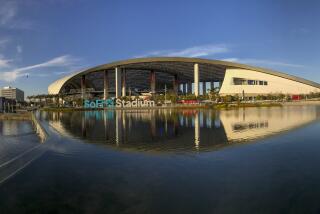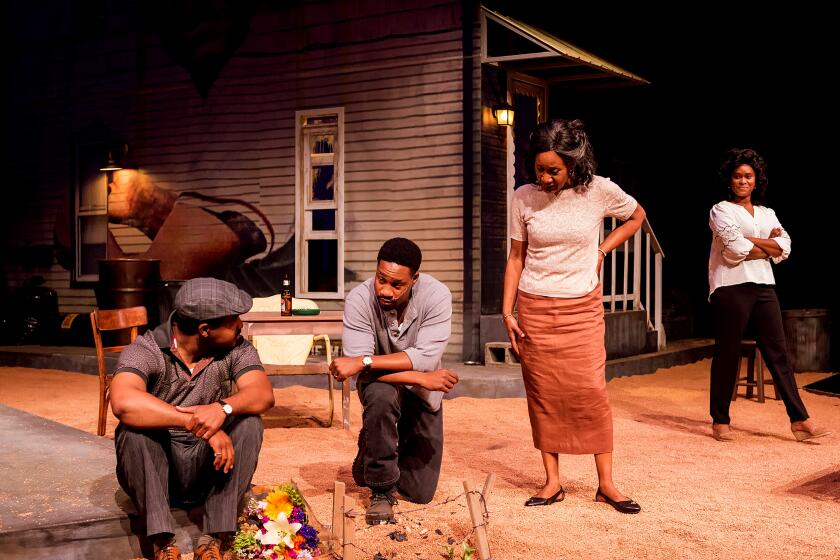Destination Crenshaw art project aims to reclaim the neighborhood for black L.A.
On a crisp late fall day, hundreds of South L.A. community leaders, activists and longtime residents convened on the top level of a parking structure adjoining the Baldwin Hills Crenshaw Plaza shopping center. What lured them there: a private preview of Destination Crenshaw, a 1.3-mile open-air museum that planners said will offset the effects of gentrification and revitalize the vibrant heart of black Los Angeles.
As the sound of an R&B band floated through the air, the crowd separated into groups and entered small tents where Destination Crenshaw leaders outlined specific facets of the project. In one tent, Perkins+Will architects showed renderings of the design. In another, artist, gardener and activist Ron Finley described how Crenshaw Boulevard would be transformed by art, the open-air museum anchored by two large monuments and featuring more than 100 rotating and permanent art installations on sidewalks, business facades and public structures tackling themes like community resiliency and Afro-futurism in South L.A.
“What we’re doing here is gangsta as hell,” Finley said to a rapt audience.
Studio-MLA landscape architect Anton Smith spoke about plans to add more than 800 trees back into the community. And before describing the themes guiding Destination Crenshaw, including togetherness, improvisation and dreams, lead historian Larry Earl promised that the project would put an end to cultural erasure in the community.
Spearheaded by City Councilman Marqueece Harris-Dawson, the project will stretch along Crenshaw Boulevard between 48th and 60th streets, flanking the new Crenshaw/LAX Metro rail line. Construction is slated to begin this year and finish by spring 2020.
Although the art project may be unfamiliar to many in the city, that may soon change given the notable black Angelenos who have gotten involved. Destination Crenshaw is led by a team of artists, academics and community planners including California African American Museum deputy director and chief curator Naima Keith, rapper and entrepreneur Nipsey Hussle, UCLA Dean of Social Sciences Darnell Hunt, and James Burks, director of special projects for the Los Angeles Department of Cultural Affairs. Taking cues from African American art and culture destinations across the country including Harlem and the National Museum of African American History and Culture, it seeks to highlight and celebrate the legacy of black contributions in the city and across the nation.
And whereas art gentrification in places like Boyle Heights has taken the form of private (and some might say elitist) galleries, the art of Destination Crenshaw is meant to be free and public, as much a reflection of the community’s past as its future.
It’s a direct response to what some felt was the city’s historical neglect of the neighborhood — and construction of the Crenshaw/LAX line, an 8.5-mile light rail route that’s part of an ambitious project to connect LAX with L.A. County’s mass transit system. After initial plans were unveiled in 2008, critics were upset that the line did not include a station in the core of the community.
Instead of constructing the rail line underground or elevated above street traffic, the segment from 48th to 60th streets will run at street-level, a design that has been linked to increased accidents and fatalities. Construction also would wipe out some 400 trees in the area, Smith said.
It’s cheaper to build at-grade than to build underground or with elevated tracks, said Joanne Kim, Destination Crewshaw project lead and senior adviser to Harris-Dawson. “Wilshire, they went underground. Hollywood Boulevard, underground. Westside, they’re going above ground or underground. It’s an insult to build at-grade.”
In 2013, activists celebrated the approval of a station in Leimert Park, a hub of African American business and culture, after years of fighting the Metropolitan Transportation Authority. But the Metro line also dredged up deep concerns about gentrification.
Los Angeles’ African American population has been declining for two decades. In Leimert Park, black people make up 70% of the population, down from 83% in the 1980s. As gentrification has approached, some residents were concerned that the train would drive up housing prices and catalyze a push-out. The arrival of the light-rail line coincides with development in the area, including a $500-million renovation of the Baldwin Hills Crenshaw Plaza that will include new retail space and housing, most at market rate.
“The community demanded that we have a response to the investment of Metro and the train,” Harris-Dawson said. “We really wanted to look at how do we use the opportunity that the rail presents to solidify, to restore the historic African American community in Southern California, and doing it in a way that benefits the people who already live there.” And, the councilman said, “provide a window into who we are for the people using the rail.”
In fall 2016, Harris-Dawson assembled black L.A. leaders to ensure they had a voice in the creative direction of Destination Crewshaw. Project organizers were particularly inspired by what Kim called the African American art and culture renaissance in L.A. — local artists like Mark Bradford, Pulitzer Prize-winning rapper Kendrick Lamar, Oscar-nominated director Ava DuVernay and Black Lives Matter co-founder Patrisse Cullors.
For a model they looked to Harlem, the New York neighborhood known as an African American cultural hub since the 1920s. They also looked locally at communities including Little Tokyo and Boyle Heights, those with a strong sense of cultural identity. They began to see the opportunity of a street-level train — more eyes on South L.A.
Destination Crenshaw “will be a celebration for the community and a source of pride. It will also have the eyes of people from all over the world, literally, as this is the train that comes from LAX,” Kim said. “The station is at the gateway to the city of L.A. We believe that it’s important that the gateway starts at the black community.”
Perkins+Will, an architecture firm that worked on the Smithsonian’s National Museum of African American History and Culture and Detroit’s Motown Museum, signed on in 2017 to lead the design and construction.
“What was clear was being able to tell a very large story about this community being there for so long and also the contribution of all the major players and heroes that have come out of that community,” lead architect Zena Howard said. “We began thinking about how you could tell the story not in a chronological way, not like a history museum, not in a didactic way, but more in an experiential way.”
Destination Crenshaw renderings showed a revamp of the historic Crenshaw Wall, also called “Our Mighty Contribution,” a mural depicting African American icons — and recently defaced with swastikas. They also revealed plans for a community amphitheater with an overlook, plus more than 10 pocket parks and parklets, adding 4 acres of parkland to the area.
Howard, who was a senior project manager on the Smithsonian’s museum of African American history, noted similarities between that project and Destination Crenshaw.
“Both are telling stories that either have never been told or that have been told wrongly,” Howard said.
CAAM chief curator Keith agreed.
“What I love about the museum in D.C., it’s focused on African American history is American history,” she said. “And I think that’s what Destination Crenshaw is also doing. Black L.A. history is L.A. history.”
The art and culture project will cost $100 million, Kim said, with most funding coming from private donors. Kim declined to give details about donors and how much money has been raised. “For the most part, we are in the silent phase of the capital campaign and so we will be making some announcements when our donors want to go public,” she said.
The Metro-funded Crenshaw/LAX line will also have some impact on Destination Crenshaw.
“No local, state or federal Crenshaw/LAX Transit Project funds are being used to directly support Destination Crenshaw,” Metro spokesman Jose Ubaldo said by email. “However, the design and construction of certain streetscape improvements previously approved as part of the Crenshaw/LAX Transit Project was adjusted to support the vision and goals of the Destination Crenshaw team.”
Can an art and culture project become a harbinger of further gentrification? Although Destination Crenshaw is described as a “counterbalancing force against gentrification,” about 10 miles away Boyle Heights, a hub for Latinos in L.A., has publicly wrestled with the arrival of new art spaces. Following the 2013 launch of the art space 356 Mission, more than a dozen galleries popped up in the neighborhood. After intense backlash against artist outsiders and fears of cultural erasure in the community, several galleries have since closed.
Destination Crenshaw leaders said they are committed to commissioning local artists and local contractors. A call for artists posted last year required that applicants be residents of L.A. County for at least five years and be educated or employed in L.A. County for three years. This spring, the curatorial committee plans to open up the call for more artists who have a connection to the L.A. black arts community.
Earl Ofari Hutchinson, president of the Los Angeles Urban Policy Roundtable and a longtime Crenshaw district resident, acknowledged the importance of recognizing black Angeleno artists through the project. “It also could be a boost for tourism, and an aid to small and minority businesses in the area,” Hutchinson said via email.
But he also noted that Destination Crenshaw is no match against market forces. If organizers think this will halt or slow gentrification, “that’s unrealistic at best and a delusion at worst,” Hutchinson said. “It’s prime real estate, centrally located, and it’s driven by the market. These neighborhoods are prime for change and that means more young, middle-class whites and other non-whites will choose to buy and live in neighborhoods like Crenshaw.”
The art upgrade along Crenshaw Boulevard could lure more outsiders, said Lance Freeman, a professor in Columbia University’s urban planning program.
“Sometimes people are drawn to the area because they’re looking for some place they think has a unique cultural aesthetic,” Freeman said. “People, sometimes they’re just looking for cheaper housing. Sometimes people are looking for some place that they think is interesting to live.”
Kim was clear that the project would not address the housing crisis, but it would stamp the area with the history and culture of African Americans. By ensuring that the Crenshaw district remains “unapologetically, authentically black,” art and design can help counteract the effects of push-out, Howard said.
“We know that mass gentrification is a problem, there are tons of forces that contribute to that — largely economic forces that we as designers can’t always control,” Howard said. “I see a huge parallel between what this work is doing and addressing those social ills.”
Marcus Hunter, UCLA associate professor in sociology and African American studies department chair, led a research project on black L.A. for Destination Crenshaw. He called Harlem, one of the project’s inspirations, a cautionary tale. Similar to South L.A., Harlem has faced problems with affordability and a declining black population.
Hunter doesn’t want to see Destination Crenshaw becoming “almost like a time capsule about people who used to be there and what they used to do and what used to happen, because that’s kind of what Harlem is becoming,” he said.
For Finley, a near-lifelong South L.A. resident, Destination Crenshaw won’t combat gentrification, but it will instill a deep sense of community pride.
“They’re coming anyway,” he said. “If we would’ve made these communities more inhabitable, more beautiful, more people friendly … we wouldn’t have this problem. People wouldn’t want to leave.”
After listening to presentations about Destination Crenshaw, event producer and community activist Nina Womack paused before heading into the final tent to complete an exit survey.
As a 50-year South L.A. resident, she grew up in an era when white people fled the area following the 1965 Watts Riots. She stayed when so many others left, she said, when drugs and gangs flowed through the neighborhood. “I was never really proud of my community,” she said. “When I would go to the Westside, to Beverly Hills or Santa Barbara, I would have to come back into my community and I would be disappointed.”
She felt excited by the prospect of positive change in South L.A. — and the opportunity to be included in the conversation.
“We’re coming into a whole new, where we are proud to be in our community because it’s going to be beautified, there’s going to be trees everywhere, artwork,” Womack said. “This gives a whole sense of renewal and hope that we can get involved and have a voice.”
More to Read
The biggest entertainment stories
Get our big stories about Hollywood, film, television, music, arts, culture and more right in your inbox as soon as they publish.
You may occasionally receive promotional content from the Los Angeles Times.







